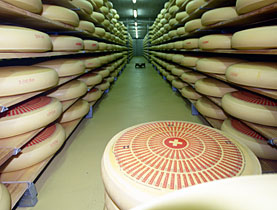
Cheesemakers celebrate boom year

Exports of Swiss cheese hit a record high in 2007, with 59,303 tonnes of various makes, including fondue mix, heading abroad.
Imports of cheese also increased, showing that the gradual liberalisation of the European cheese market had led to a clear increase in the exchange of goods, according to the Swiss Cheese Organisation.
A total of 3,235 tonnes more cheese was exported in 2007 than the previous year, a rise of 5.8 per cent. Emmental AOC was the star performer, shifting 1,291 more tonnes than in 2006.
“Swiss cheese is still considered an interesting product abroad – our specialities are very popular among consumers as they grow naturally and are of a very high quality,” David Escher, director of the Swiss Cheese Organisation, told swissinfo.
Other cheeses that did well included Switzerland Swiss, Tête de Moine AOC and Tilsiter.
“Switzerland is a country where hard and semi-hard cheese is produced – we are very strong on these products. On soft cheeses we are perhaps less strong than the French,” Escher said. “Emmental AOC falls into the former category and has been our best seller abroad for ever.”
Many specialist semi-hard cheeses were also in demand. “People are looking for that special taste which they can’t necessarily find in their own countries,” he said.
Not doing so well however were Gruyère AOC and ready-to-use fondue mix, exports of which dropped by 294 and 266 tonnes respectively.
“They have gone down a bit for various reasons,” Escher admitted. “Prices went up a bit in 2007 but also a massive amount of Gruyère AOC was exported in 2006. Also the competition is not sleeping! In France in particular Comté is a similar product to Gruyère AOC and is being strongly marketed.”
Great import
Cheese exports play an important role in the Swiss dairy but also national economy, according to the cheese organisation. More than 40 per cent of milk is turned into cheese, a third of which is exported.
The main export market is Italy, followed by Germany, France and the United States.
However, last year was also good for cheese imports, which rose by 11.9 per cent to 37,329 tonnes.
The cheese organisation said increases could be seen above all in the categories of “other cream cheeses”, “other soft cheeses”, other semi-hard cheeses” and “other hard cheeses” – “basically competitively priced goods destined for large retailers or the industrial sector”.
Since the gradual liberalisation of the cheese market within the European Union in 2002, Swiss exports have risen by 6,587 tonnes, or 12.5 per cent, with imports also increasing by 6,142 tonnes, or 19.7 per cent.
“The future is looking good for exports as long as prices stay stable,” according to Escher.
swissinfo, Thomas Stephens
The origins of cheesemaking are not known, but it is unlikely to be a Swiss invention.
The first historic reference to cheese is about 3,500 years old and it is mentioned in the Old Testament.
The ancient Roman historian, Pliny the Elder, wrote in the first century about a cheesemaking tribe living in a region that is now Switzerland.

In compliance with the JTI standards
More: SWI swissinfo.ch certified by the Journalism Trust Initiative





























You can find an overview of ongoing debates with our journalists here . Please join us!
If you want to start a conversation about a topic raised in this article or want to report factual errors, email us at english@swissinfo.ch.